In the rapidly evolving world of artificial intelligence, ChatGPT, developed by OpenAI, has established itself as a leading large language model (LLM). However, Claude, the innovative AI from Anthropic, has recently emerged as a formidable competitor, boasting an impressive array of capabilities. This article pits Claude (3.5 Sonnet) against ChatGPT (4o) in a head-to-head comparison, evaluating their performance across three diverse tasks: crafting a Python script to extract text from the New York Times homepage, analyzing the retrieved content, and designing a comprehensive Japanese language lesson plan. Our in-depth analysis aims to illuminate the strengths and limitations of both AI models, offering valuable insights for developers, data analysts, and language enthusiasts. Join us at paive-ai as we delve into this cutting-edge exploration of Anthropic’s Claude versus OpenAI’s ChatGPT, uncovering how these AI powerhouses stack up in real-world applications.
Python Script Comparison: Claude’s Superior Code Quality
Prompt
Create a Python script to extract text from the New York Times’ front page.
ChatGPT
import requests
from bs4 import BeautifulSoup
# Define the URL of the NYT front page
url = 'https://www.nytimes.com/'
# Send a request to fetch the HTML content of the page
response = requests.get(url)
# Check if the request was successful
if response.status_code == 200:
# Parse the HTML content using BeautifulSoup
soup = BeautifulSoup(response.content, 'html.parser')
# Find all elements containing text
text_elements = soup.find_all(['p', 'h1', 'h2', 'h3', 'h4', 'h5', 'h6', 'span'])
# Extract and concatenate the text from all elements
extracted_text = '\n'.join(element.get_text() for element in text_elements)
# Print the extracted text
print(extracted_text)
else:
print(f'Failed to retrieve the page. Status code: {response.status_code}')
Claude
import requests
from bs4 import BeautifulSoup
def extract_nyt_text():
# URL of the New York Times front page
url = "https://www.nytimes.com/"
# Send a GET request to the URL
response = requests.get(url)
# Check if the request was successful
if response.status_code == 200:
# Parse the HTML content
soup = BeautifulSoup(response.text, 'html.parser')
# Find all text elements
text_elements = soup.find_all(text=True)
# Filter out script and style elements
visible_text = [t.strip() for t in text_elements if t.parent.name not in ['style', 'script', 'head', 'title', 'meta', '[document]']]
# Remove empty strings and join the text
extracted_text = ' '.join(filter(bool, visible_text))
return extracted_text
else:
return f"Failed to retrieve the webpage. Status code: {response.status_code}"
# Run the function and print the result
print(extract_nyt_text())Analysis
When comparing the Python scripts generated by Claude and ChatGPT, it becomes evident that Claude’s code demonstrates superior efficiency and quality. The key advantage of Claude’s approach lies in its broader, more adaptable, and reusable solution. Unlike ChatGPT’s output, Claude’s code is structured to return a single, comprehensive object containing all extracted data. This architectural decision enhances maintainability and scalability while simplifying data handling. The uniform return format streamlines further data processing and facilitates easier system integration with other platforms. Moreover, Claude’s code exhibits better organization and adherence to Python best practices, making it more readable and easier to modify or extend. This sophisticated code production highlights Claude’s deep comprehension and application of complex programming concepts, giving it a distinct edge in this task.
Text Analysis: Claude’s Human-Friendly Approach
Prompt
Count how many times the word “Trump” appears and in which context.
ChatGPT


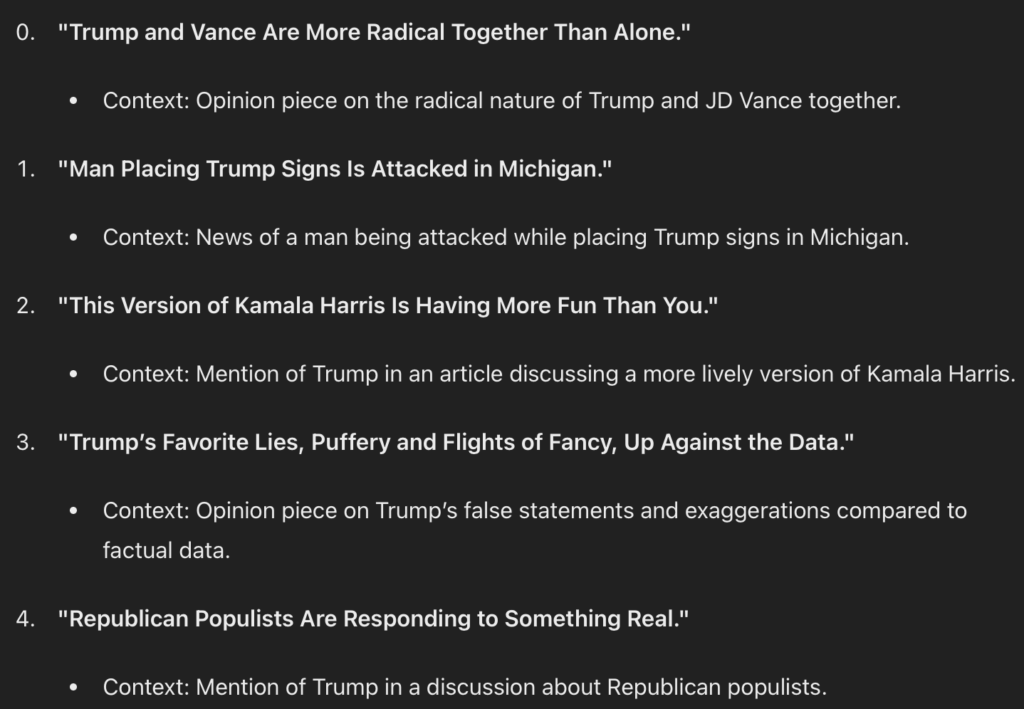
Claude

Analysis
To further compare Claude and ChatGPT, we tasked both models with analyzing their own outputs, specifically counting occurrences of the word “Trump” and specifying contexts. The results revealed notable differences in their approaches. Claude demonstrated a tendency to group similar contexts, resulting in a more human-friendly and concise output. While Claude’s response may have contained slightly less information, it presented the data in a more digestible format. In contrast, ChatGPT provided a longer, more detailed answer, naturally incorporating more information but potentially at the cost of readability.
Work plan to learn Japanese in 6 months from scratch
Prompt
Give me a work plan to learn Japanese from scratch in 6 months.
ChatGPT
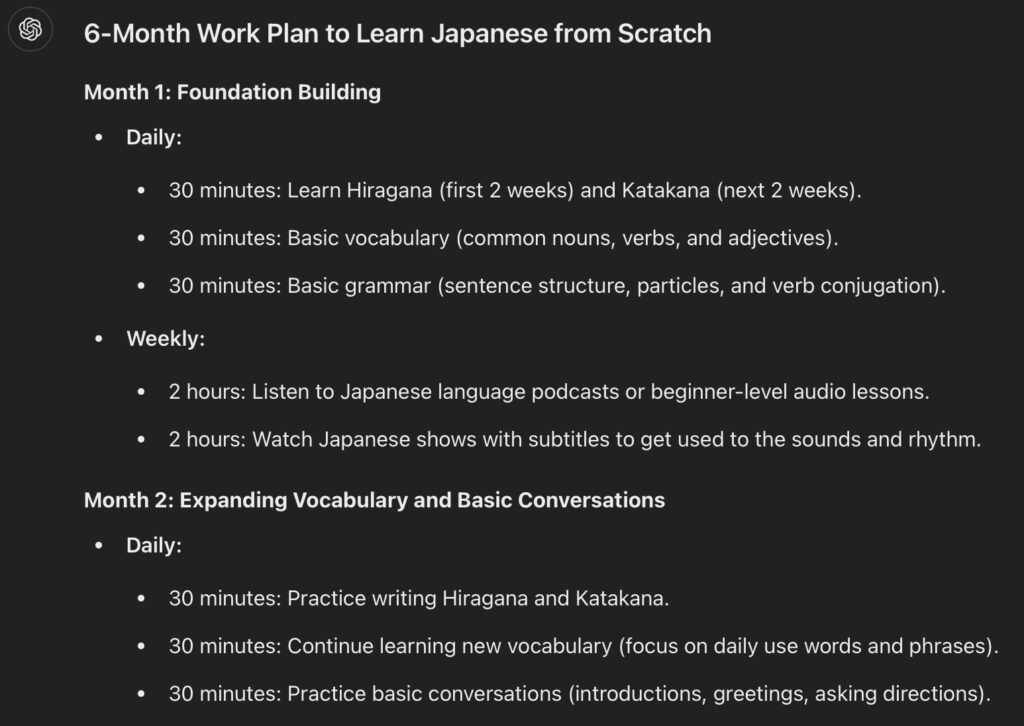
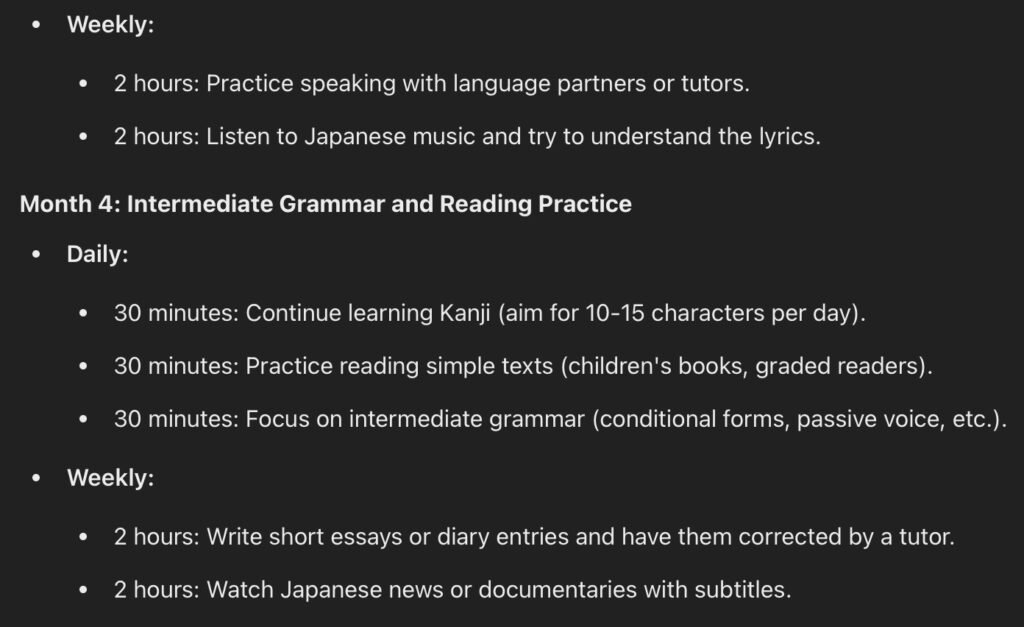
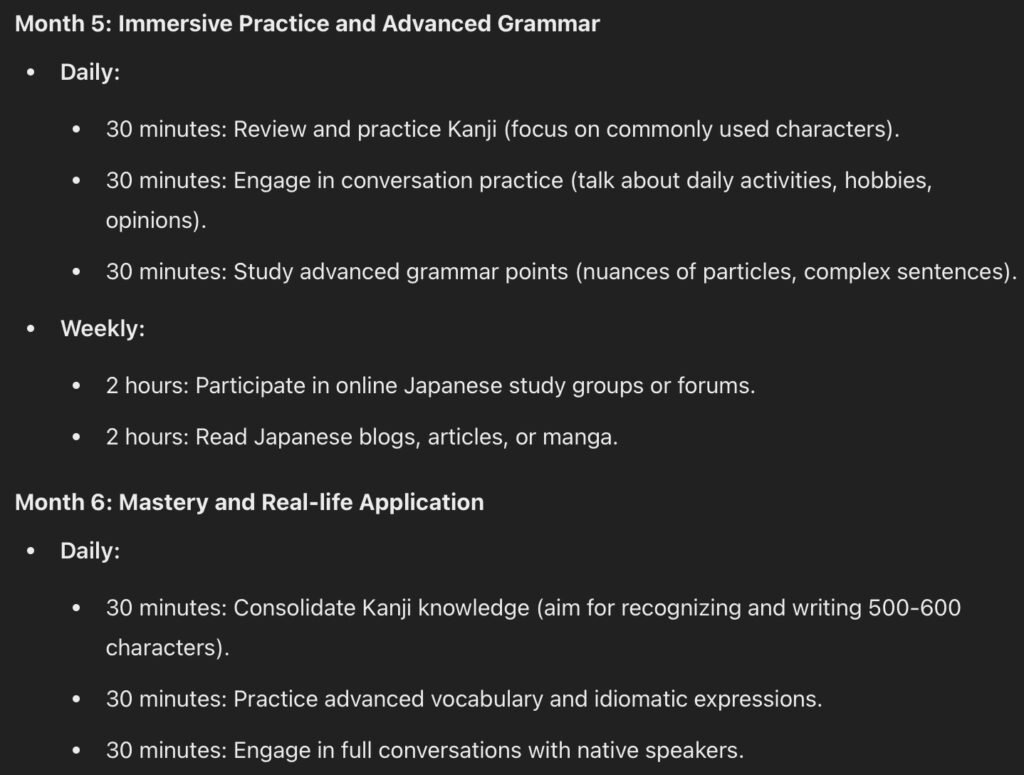
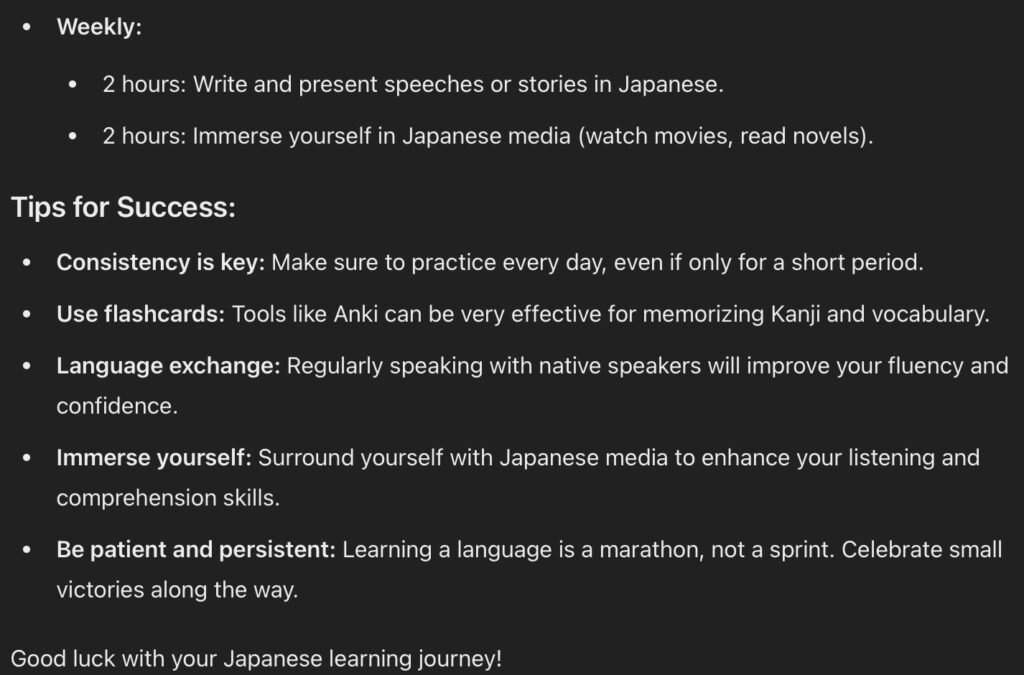
Claude
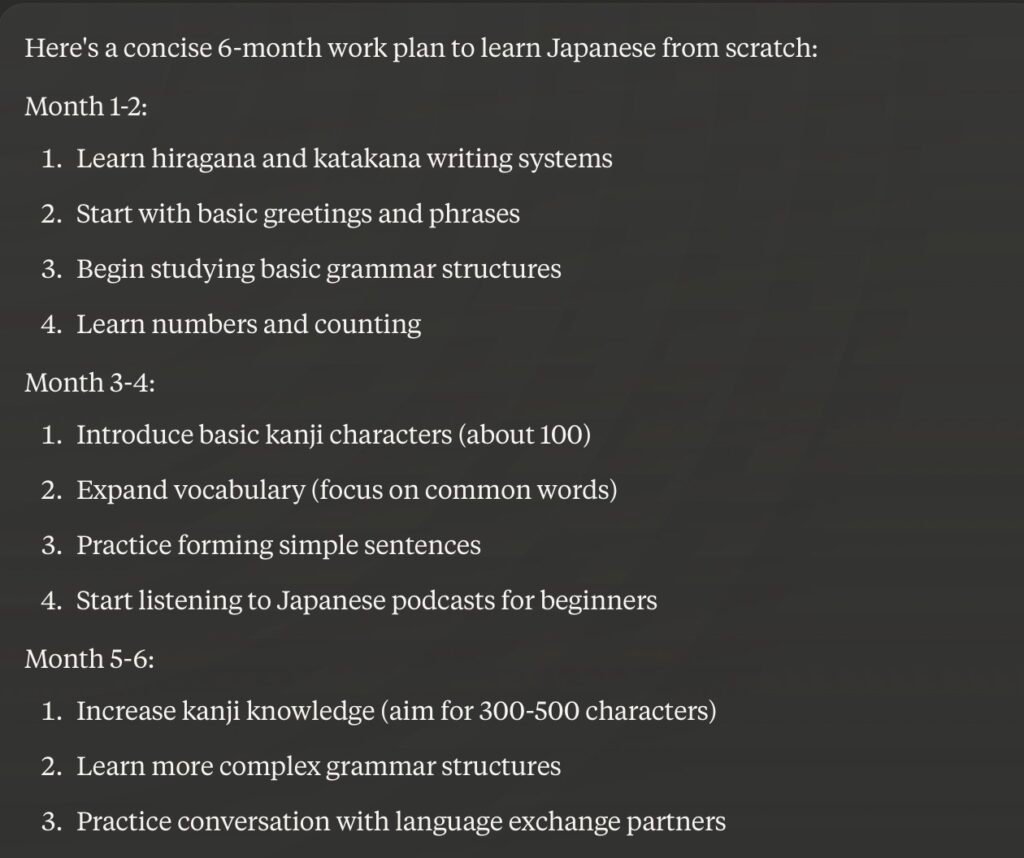
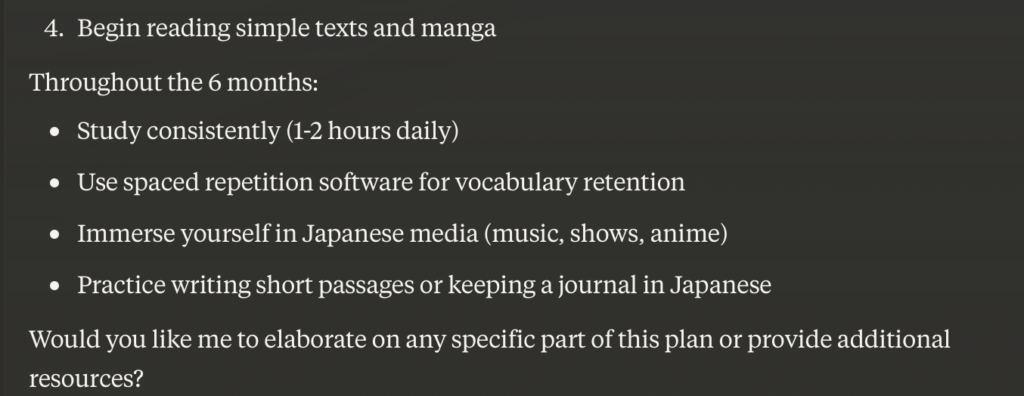
Analysis
In the realm of tutoring and lesson planning, ChatGPT showcases exceptional adaptability and context retention. Its ability to customize responses based on the user’s comprehension level and past interactions enables a tailored educational experience. This feature is particularly crucial in educational settings where lessons need to evolve with the learner’s understanding. ChatGPT’s capacity to build upon previously covered content throughout extended conversations facilitates a coherent and cumulative learning process.
While Claude demonstrates proficiency in handling various conversational tasks, it may not preserve context as effectively during prolonged exchanges. This limitation could potentially restrict its applicability in learning environments where progression and continuity are essential. ChatGPT’s sophisticated understanding of complex educational material and its capacity for dynamic adaptation allow it to excel in creating intricate and personalized learning experiences.
Conclusion
Our comparison reveals that both Claude and ChatGPT possess unique strengths in different areas. Claude showcases superior capabilities in code generation and presents information in a more human-friendly manner. Meanwhile, ChatGPT excels in educational contexts and provides more detailed responses in text analysis tasks.
As AI technology continues to advance, tools like Claude from Anthropic and ChatGPT from OpenAI will play increasingly significant roles across various fields. To stay informed about the latest developments in AI, including updates on Claude and ChatGPT, follow paive-ai for regular insights, in-depth analyses, and curated AI solutions tailored to meet the diverse needs of developers, analysts, and AI enthusiasts. If you enjoyed reading this article, you will probably be interested in this article about how entrepreneurs are using AI nowadays.

Leave a Reply